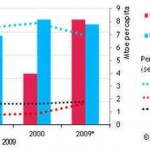Sectors
This comprehensive study set out a wide range of reporting and disclosure in 10 economic sectors:
- Utilities
- Materials
- Energy
- Industrials
- Telecommunications
- Consumer Staples
- Consumer Discretionary
- Information Technology
- Financials
- Healthcare
Statistics
Some companies disclose the potential risk of future climate or environmental protection regulations, while some disclose the more imminent risks of non-compliance with current regulations. Risk related to weather is the most highly reported indicator (246 out of 364 companies, more than 75 percent) in each sector. Physical risk from severe weather events can occur anywhere within a company’s operation, or among its supply chain or downstream, but it is rare that these natural disasters are directly attributed to climate change, and none of the healthcare-sector companies researched reported physical risks related to climate change. In fact, out of 364 companies researched, only 39 recognized climate change (10.7 percent) at all, while only four of 364 companies reported their greenhouse gas emissions.
Out of 364 companies, 56 had countable disclosures under the sustainability reports and initiatives indicator, either for publishing sustainability and CSR reports or providing other information on the company’s initiatives to improve or mitigate its environmental impact.
The industrials sector stands out for 31 companies, or 50 percent of companies researched, disclosing a variety of products and services – which indicates that there probably are numerous competitive opportunities to develop low-carbon products and technologies for the sector as a whole. Companies in the commercial and professional services industry, which comprise six of these 31 industrials, lead the sector with a variety of climate-friendly products and services.
The four sectors that generally have the greatest impact on the environment and climate change – utilities, materials, energy, and industrials – ranked highest for overall disclosure, based on the eight indicators. The financials, information technology, and healthcare sectors rank in the bottom three, with healthcare consistently at the bottom.
Vision and Preparation
Reporting and disclosure are important because they show a company’s vision and preparedness for the future. However, the risks can be markedly different from sector to sector, or industry to industry. For example, in the financial sector, real estate investors and insurance companies alike are beginning to incorporate climate change into their decisions. Where semiconductors are manufactured will matter for the future of the digital age if countries such as Korea, Japan and Taiwan remain vulnerable to physical changes – or if drought conditions persist in the American southwest or Israel. Pharmaceutical companies will face a significantly altered landscape in terms of markets as diseases that were once mainly tropical expand into temperate latitudes and as sources for raw materials are affected.
As an example of how climate change will affect just one sector, consumer goods, the report notes that the consumer discretionary sector is exposed to climate risk within its supply chain through its dependence on raw materials, manufacturing and transportation. Yet the report found that recognition of climate change and its attendant risks and opportunities are rare among small- and mid-cap companies that are well represented in that sector.
Significant opportunities await companies that can best evolve and serve investors and consumers in the low-carbon business climate. In a low-carbon future, consumers will want to lead a low-carbon lifestyle, businesses to run carbon-efficient operations, governments to reach national greenhouse gas emissions targets, and investors to run portfolios with known and managed climate-related risks. A growing number of investors are already aware of the varied financial risks and opportunities presented by climate change, and incorporating that awareness into portfolio management and shareowner advocacy.
Reporting
Over the past several years, there has been a great deal of progress in reporting of greenhouse gas emissions and climate-related risks and opportunities, but much work still remains. Due to EPA carbon-emission reporting requirements, the voluntary Carbon Disclosure Project and the SEC’s 2010 interpretive guidance on reporting climate-related matters, we believe that reporting and disclosure will pick up substantially in the coming years. However, while the SEC’s interpretive guidance addresses a broad spectrum of climate-related risks and opportunities, the only mandatory directive is EPA’s new requirement, which will likely affect most companies of a size large enough to be listed on public exchanges, and that mandate to disclose greenhouse gas emissions will inform investors’ views on regulatory and possibly litigation risk. But it does not address physical, competitive or supply chain risks or opportunities at all.
Nonetheless, it is the objective of most small companies to grow and become large ones. While most of the public and investor attention on corporate vulnerabilities or strengths stemming from climate change has focused on large companies whose names are familiar to most people, this large-company attention bias will not continue forever. As the effects of climate change become more apparent, small companies cannot continue to rely on the public attention deficit to shield them from major reputational or brand-value impacts resulting from their inattention to climate.














